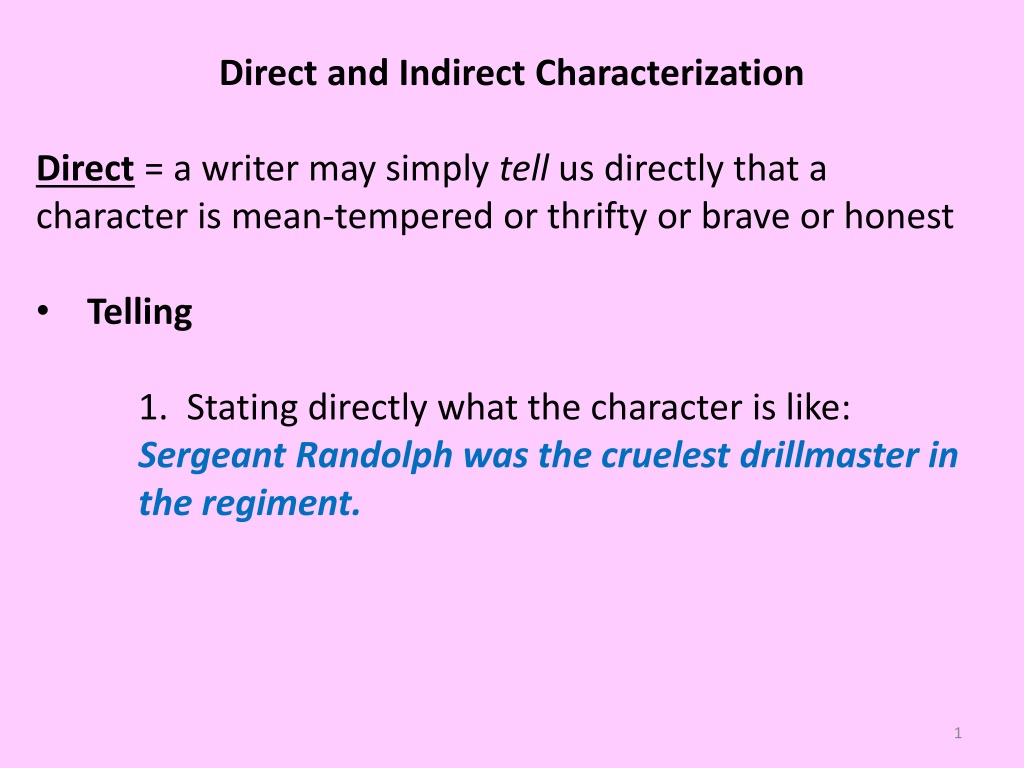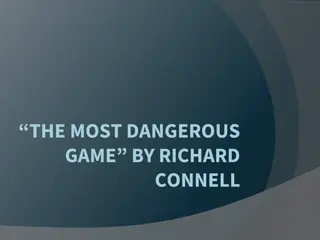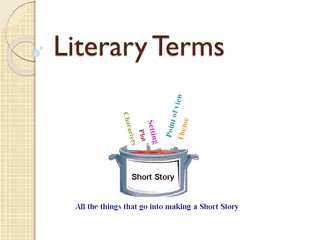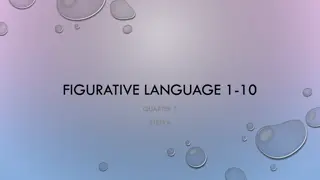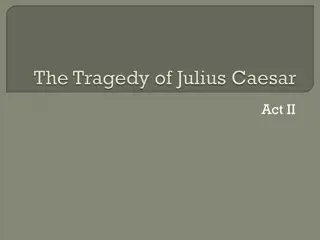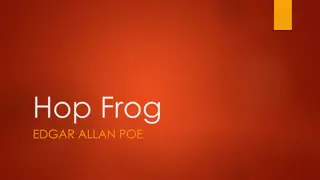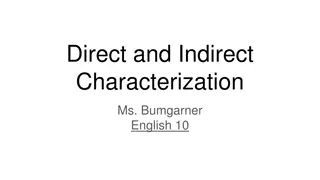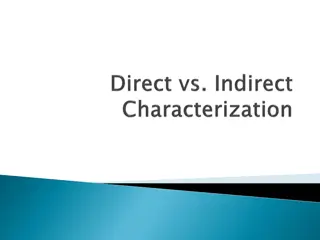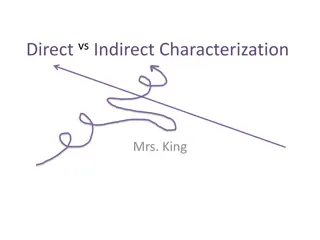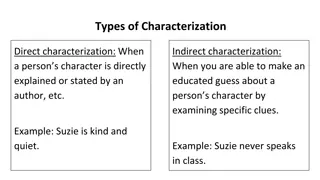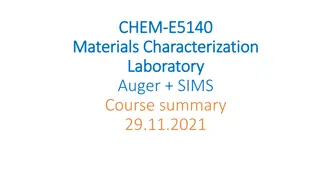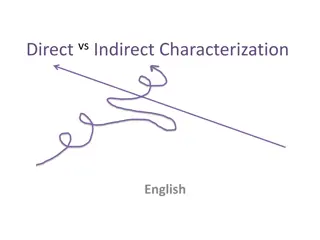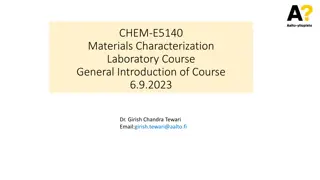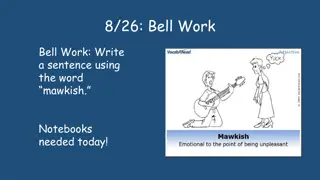Understanding Characterization in Literature
Exploring the differences between direct and indirect characterization in literature, this content explains how authors convey character traits through actions, dialogue, thoughts, and interactions. It provides examples and types of indirect characterization, with a focus on speech, thoughts, effects on others, actions, and appearance. Additionally, it covers an activity where participants describe themselves using both direct and indirect characterization techniques. The piece also touches on character development and types of characters such as static, dynamic, flat, and round.
Download Presentation

Please find below an Image/Link to download the presentation.
The content on the website is provided AS IS for your information and personal use only. It may not be sold, licensed, or shared on other websites without obtaining consent from the author. Download presentation by click this link. If you encounter any issues during the download, it is possible that the publisher has removed the file from their server.
E N D
Presentation Transcript
Direct and Indirect Characterization Direct = a writer may simply tell us directly that a character is mean-tempered or thrifty or brave or honest Telling 1. Stating directly what the character is like: Sergeant Randolph was the cruelest drillmaster in the regiment. 1
Indirect = present day writers generally prefer to show their characters in action and let readers decide for themselves what kinds of people they are meeting Showing 2. Describing the appearance of the character: The woman s coat was gathered about her thin body and fastened with a safety pin. 3. Showing the character in action: Toni glanced around, then tossed her gum wrapper on the grass and kept walking. 4. Allowing the reader to hear the character speak: I don t have to do what you say, declared Darlene, glaring at the new baby-sitter. 5. Revealing the character s thoughts and feelings: Tyler didn t like the looks of the squash pudding but decided to eat some to please the cook. 6. Showing how others react to the character: Team up with Erica? said Jorge. Well, OK, if you can t get anyone else. But when she was my partner before, I did all the work while she socialized. 2
Types of Indirect Characterization: Speech Thoughts Effects on Others Actions Looks 3
Activity 1. Complete the characterization worksheet graphic to describe yourself using complete sentences and quotes when writing dialouge. 2. Meet with a partner and have the partner read the paragraph that you wrote about yourself. 3. Each of you will record on a T-chart the direct and indirect characterization that is identified in your partner s paragraph. 4
Character Direct Characterization 5
Indirect Characterization Character s Name Descriptions and Page numbers Speech Thoughts Effects on others Actions Looks 6
Types of Characters 7 Static - When people say that a character is "static," they're referring to the fact that a character doesn't change. Example: Gale (Hunger Games) Dynamic These characters will undergo some kind of change in the course of the story. Example: Haymitch Flat These characters are minor characters in a work of fiction who do not undergo substantial change or growth in the course of a story. Example: President Snow Round - This is a major character in a work of fiction who encounters conflict and is changed by it. Round characters tend to be more fully developed Example: Ebenezer Scrooge, Katniss Everdeen 7
8 Textual Evidence from Story Exemplifying Four Types of Characters Characters - Alfonso, Sondra, and Ernie Place the characters in the appropriate category of Static or Dynamic and Flat or Round. Explain using textual evidence to support your response. 8
9 Character s Point of View Broken Chain Characters - Alfonso and Ernie Read the passage beginning with the first full paragraph/ the words For the next hour on page 33 through the paragraph ending with the words might have found a girlfriend . This passage is written in 3rd person point of view and shares how both Ernie and Alfonso are feeling. Write the situation in the passage from Ernie s or Alfonso s point of view using first person. Use true details from the passage while being creative. For example: I can t believe my brother is such a jerk. 9
10 Character s Point of View Broken Chain Share your first person POV writing piece with your team and choose Discuss your analysis. 10
Conflicts Internal A conflict that takes place within a character s mind Example = A conflict between a character and something in himself or herself: perhaps fear, shyness, homesickness, or an inability to make a decision (character vs himself/herself) External- A character struggles with an outside force Examples= A conflict between two characters (character vs character) A conflict between a character and a group or a whole society (character vs society) A conflict between a character or a natural force or event, such as a flood or the law of gravity (character vs nature) A conflict beyond a character s control (character vs destiny) 11
Broken Chain Modeling Conflicts Character vs himself/herself Alfonso sat on the porch trying to push his crocked teeth to where he thought they belonged. He hated the way he looked. Last week he did fifty sit-ups a day, thinking that he would burn those already apparent ripples on his stomach to even deeper ripples, dark ones, so when he went swimming at the canal next summer, girls in cut-offs would notice (Soto 29). Character vs Character He asked his mother if he could have braces, like Frankie Molina, her godson, but he asked at the wrong time. She was at the kitchen table licking the envelope to the house payment. She glared up at him. Do you think money grows on trees? (Soto 30). Character vs Society Alfonso studied the magazine pictures of rock stars for a hairstyle. He liked the way Prince looked-and the bass player from Los Lobos. (Soto 30) Character vs Nature Character vs Destiny On an impulse he removed the chain to wipe off the gritty oil. But while he was unhooking it from the back sprocket, it snapped. The chain lay in his hand like a dead snake (Soto 34). 12
Oranges By Gary Soto Independent Work Identify the different types of conflict from the poem and cite evidence to support your responses. What potential conflict was avoided and how? *Not all conflicts will be represented. 13
Elements of Story Model / Discuss A Christmas Carol Summary of the Christmas Carol On Christmas Eve, four ghosts teach Scrooge, an elderly miser, that love and friendship are much more important than amassing a fortune. The first ghost is that of Marley, his former business partner, who warns him about the suffering awaiting him if he does not change. The three other ghosts reveal to Scrooge scenes from his past, present and future. After witnessing these scenes, Scrooge is a changed man. A one sentence theme for the Christmas Carol A change of heart and perspective makes one realize what is most important in life. Think about if the Christmas Carol did not include Ebenezer s experiences with one of the ghosts; how would the overall theme of the play be affected? Would Ebenezer and the readers learn the lessons they did if the ghost was eliminated? (Ghost of Christmas Past, Ghost of Christmas Present, Ghost of Christmas Future) 14
Elements of Story: Model & Discuss A Christmas Carol The 5 major Elements of story are: Theme, Character, Setting, Plot Conflict Element #1 Theme The theme is the central idea or belief in a short story, sometimes described as the author s message about life. Let s Consider a one sentence theme for the story A Christmas Carol Example: A change of heart and perspective makes one realize what is most important in life. 15
Element # 2 Characters A character is a person, or sometimes even an animal, who takes part in the action of a short story or other literary work. Types of Characters : Round, Flat, Static and Dynamic. Consider the each of the characters below in the beginning and then in the end of the story to decide what type of character they are. 1) Ebenezer, 2) three ghosts, 3) Bob Cratchit Internal v/s External Characteristics: Internal Characteristics describe what someone is like on the inside For example: Positive, resilient, wise External Characteristics Describe what someone is like on the outside For Example: Pale, red-eyed, plump Consider the Internal Characteristics of each character: Ebenezer, Bob Cratchit Consider the External Characteristics of each character: Ebenezer, Bob Cratchit 16
Element # 3 Plot A plot is a series of events and character actions that relate to the central conflict. Consider the main events of A Christmas Carol in each part of the plot line: Exposition, Rising action, Climax, Falling Action and Resolution Element #4 Setting The setting of a short story is the time and place in which it happens. Authors often use descriptions of landscape, scenery, buildings, seasons or weather to provide a strong sense of setting. Consider these 7 main settings of A Christmas Carol during the exposition, rising action, climax, falling action, and resolution and how they contribute to the theme 1) The office, 2) Scrooge s house, 3) past, 4) present, 5) future, 6) Scrooge in the Streets the morning after , 7) Bob Cratchit s house. 17
Element #5 Conflict The conflict is a struggle between two people or things in a short story. The main character is usually on one side of the central conflict. On the other side, the main character may struggle against another important character, against the forces of nature, against society, destiny or even against something inside himself or herself (feelings, emotions, illness). Consider: Ebenezer vs. Bob Cratchit, Ebenezer vs. ghosts External Conflict: A character struggles with an outside force Example = A conflict between a character and something in himself or herself: perhaps fear, shyness, homesickness, or an inability to make a decision. Consider: Ebenezer Vs. Ebenezer Internal Conflict: A conflict that takes place within a character s mind The next Step Consider how all of the elements work together to develop the theme? Activity: Think about this theme of A Christmas Carol: A change of heart and perspective makes one realize what is most important in life. List these elements of the story : Character, Setting, Plot, Conflict. Next to each element, provide an explanation of how it contributed to the theme. 18
Elements of Story Your Turn! Choose your favorite TV series, movie, or book to analyze. Provide a summary of your TV series, movie, or book using CAMPS Provide a one sentence theme of this TV series, movie, or book Write out these prompts and fill in the blanks to create complete sentences that describe how each element of story below contributes to the theme. 1. The primary setting of_____________ was _______________, this contributes to the theme because____________________________. 2. One internal conflict the main character experiences is _________________. This contributes to the theme because_________________________________. 3. One type external conflict the main character experiences is _____________. The main idea of this conflict is _______________________. It effects the theme because __________________________. 4. One internal characteristic of the main character is _______________. This internal characteristic contributes to the theme because________________________________. 19
General Analyzing How Elements of story contribute to theme Consider the story of Broken Chain 1. Provide a summary of Broken Chain using C.A.M.P.S. 2. Provide a one sentence theme of this story Write out these prompts and fill in the blanks to create complete sentences that describe how each element of story below contributes to the theme. 3. The primary setting of_____________ was _______________, this contributes to the theme because____________________________. 4. One internal conflict the main character experiences is _________________. This contributes to the theme because_________________________________. 5. One type external conflict the main character experiences is _____________. It effects the theme because __________________________. 6. One internal characteristic of Alfonso is _________________. This contributes to the author s message (theme) because__________________________________________. 20
Elements of Story Assessment Broken Chain Step 1 Write one sentence that summarizes the theme of Broken Chain ? Step 2 Create a T chart for each of the elements of story below, include the examples required and explain how each of them contributed to the theme of Broken Chain? 1. Character: On one side of the chart Include examples of static, round, flat, dynamic, internal and external characteristics. On the other side explain how each contributed to the theme. 2. Conflict: On one side provide examples of internal and external conflict. On the other side explain how each example contributed to the theme. 21
Writing Activity Analyzing the Central Idea across Texts Broken Chain and Oranges In paragraph form, provide one sentence that describes the central idea that both Oranges and Broken Chain share. Provide one sentence that identifies the type of conflict both characters share. Provide one quote from each text that demonstrates this type of conflict and explain how each quote demonstrates the central idea. Conclude by summarizing how the main character in each piece struggled with the same internal conflict. 22
Analyzing the Central Idea across Texts: The Dust Bowl and Fields of Flashing Light In paragraph form, provide one sentence that describes the central idea that both The Dust Bowl and Fields of Flashing Light share. Provide one sentence that identifies thetype of conflict both pieces share. Provide one quote from each text that demonstrates this type of conflict and explain how each quote demonstrates the conflict. Conclude by reviewing how each piece described a similar conflict and revealed a common central idea. The Dust Bowl The most visible evidence of how dry the 1930s became was the dust storm. Tons of topsoil were blown off barren fields and carried in storm clouds for hundreds of miles. Technically, the driest region of the Plains southeastern Colorado, southwest Kansas and the panhandles of Oklahoma and Texas became known as the Dust Bowl, and many dust storms started there. But the entire region, and eventually the entire country, was affected. The Dust Bowl got its name after Black Sunday, April 14, 1935. More and more dust storms had been blowing up in the years leading up to that day. In 1932, 14 dust storms were recorded on the Plains. In 1933, there were 38 storms. By 1934, it was estimated that 100 million acres of farmland had lost all or most of the topsoil to the winds. By April 1935, there had been weeks of dust storms, but the cloud that appeared on the horizon that Sunday was the worst. Winds were clocked at 60 mph. Then it hit. "The impact is like a shovelful of fine sand flung against the face," Avis D. Carlson wrote in a New Republic article. "People caught in their own yards grope for the doorstep. Cars come to a standstill, for no light in the world can penetrate that swirling murk... We live with the dust, eat it, sleep with it, watch it strip us of possessions and the hope of possessions. It is becoming real." The day after Black Sunday, an Associated Press reporter used the term "Dust Bowl" for the first time. "Three little words achingly familiar on the Western farmer's tongue, rule life in the dust bowl of the continent if it rains." The term stuck and was used by radio reporters and writers, in private letters and public speeches. 23
Ma told me to cover the beds, push the scatter rugs against the doors, dampen the rags around the windows. Wiping dust out of everything, She made black coffee and biscuits, Waiting for Daddy to come in. Sometime after four, Rubbing low on her back, Ma sank down into a chair at the kitchen table And covered her face. Daddy did not come back for hours, Not until the temperature dropped so low it brought snow. Ma sighed, grateful, Staring out at the dirty flakes, But our relief didn t last. The wind snatched that snow right off the fields, Leaving behind a sea of dust, Waves and Waves and Waves of Dust, Rippling across our yard. Daddy came in, He sat across from Ma and blew his nose. Mud streamed out. He coughed and spit out Mud. If he had cried, His tears would have been mud too, But he didn t cry. And neither did Ma. March 1934 Fields of Flashing Light I heard the wind rise, And stumbled from my bed, Down the stairs, out into the yard. The night sky kept flashing, Lightening danced down on spindly legs. I sensed it before I knew it was coming. I heard it, I smelled it, tasted it, Dust. While Ma and Daddy slept, The dust came, Tearing up fields where the winter wheat Set for harvest in June, Stood helpless. I watched them fry, Or flatten, Or blow away, Like bits of cast-off rags. It wasn t until the dust Turned toward the house, Like a fired locomotive, and I fled, Barefoot and breathless, back inside, It wasn t until the dust hissed against the windows, until it ratcheted the roof, that Daddy woke. He ran into the storm, His overalls half hooked over his union suit. Daddy! I called. You can t stop the dust. 24
Peer Review Rubric Name of student taking the assessment:_________________________________________ The paragraph includes Points one topic sentence that accurately described the central idea of both pieces one sentence that identified the type of conflict that both pieces shared one quote from each text (two total) that accurately demonstrated the conflict explanations of how each quote demonstrated the conflict (two total) a conclusion that reviewed how each piece described a similar conflict and revealed a common central idea 5 5 /10 /10 /10 /40 Peer Review Rubric Name of student taking the assessment:_________________________________________ The paragraph includes Points one topic sentence that accurately described the central idea of both pieces one sentence that identified the type of conflict that both pieces shared one quote from each text (two total) that accurately demonstrated the conflict explanations of how each quote demonstrated the conflict (two total) a conclusion that reviewed how each piece described a similar conflict and revealed a common central idea 5 5 /10 /10 /10 /40 25
Coming of Age Short Story Activity = YOU will be writing a well developed coming of age short story. Write Source pages 343-351 Example of short story pg. 344-345 Discuss with a partner Who is the main character? What does the main character want? What gets in his/her way? How does he/she change through the story? Story Patterns pg. 350 Active vs. Passive Voice pg. 118 26
Coming of Age Short Story Map out story - graphic organizer 27
Writing Activity Analyzing Central Idea Across Texts Dust Bowl and Fields of Flashing Light In paragraph form, provide one sentence that describes the central idea that both The Dust Bowl and Fields of Flashing Light share. Provide one sentence that identifies the type of conflict that both pieces share. Provide one quote from each text that demonstrates this type of conflict and explain how each quote demonstrates the central idea. Conclude by summarizing how the main character in each piece struggled with the same internal conflict. 28
Short Story Discussion Share your plot development with two other classmates. -- Would they read your story? -- Would they make any changes? -- What is their favorite part? -- Where they confused by any action or description in the story? -- What are some words that you would use to describe the protagonist? -- What are some words that you would use to describe the antagonist? 30
Short Story Character Sketches summaries of protagonist and antagonist. What do we need to know about the character? Speech Thoughts Effects on Others Actions Looks 31
Character Round or Flat, Explain Speech Thoughts Effects on others Actions Looks 32
Coming of Age Short Story Activity = YOU will be writing a well developed coming of age short story. Write Source pages 343-351 --Revisit the example of short story pg. 344-345 --You should be able to answer the following questions about your short story: 1. Who is the main character? 2. What does the main character want? 3. What gets in his/her way? 4. How does he/she change through the story? 33
Coming of Age Short Story Peer Discussion (mid-activity check point) 1. Exchange your story with another classmate. 2. Each of you read one another s stories. 3. Discuss the following questions based on what you read and see if the answers match the author s answers. Who is the main character? What does the main character want? What gets in his/her way? How does he/she change through the story? 34
